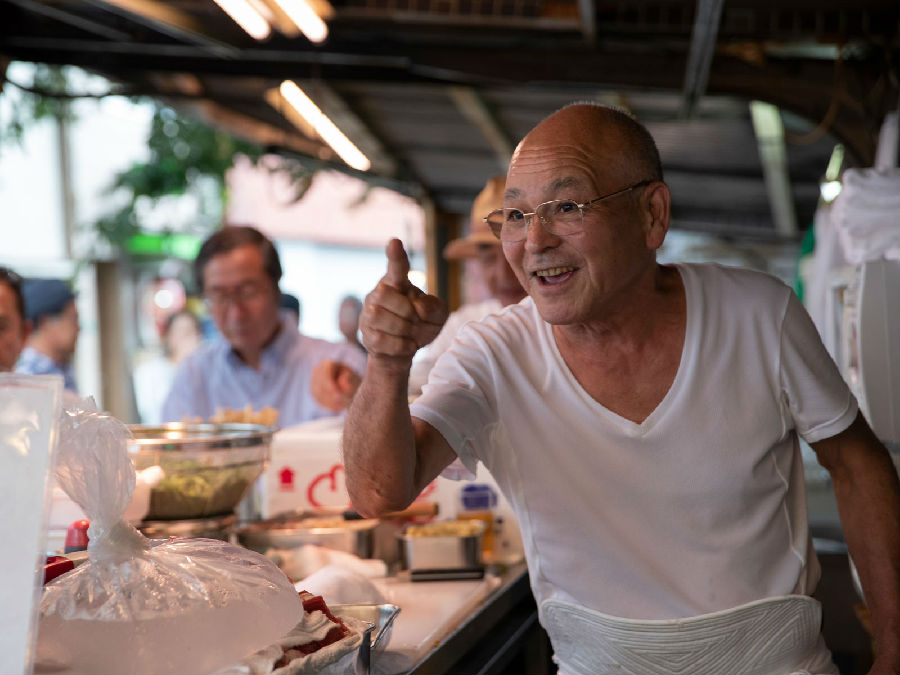《街頭美食》下的人生百味
We all have a favorite little spot to eat. Maybe it's a dumpling cart or a sandwich shop. They know your order when you walk in and they always give you extra sauce. You want to keep the place a secret but you also want to tell your friends.
我們都有個(gè)自己愛吃的小吃攤。或許是賣餃子的小推車,或許是賣三明治的小店。你一進(jìn)門,店家們都知道你要點(diǎn)些什么,還總會(huì)多給你醬汁。你想要私藏這個(gè)好地方,但也想和朋友們分享。
Well, it seems that you don't have to make that difficult choice now. A new Netflix documentary series, Street Food, aims to tell the world about all of our favorite little spots.
好吧,看來如今你不必再糾結(jié)于這個(gè)問題了。一部全新的網(wǎng)飛紀(jì)錄片《街頭美食》目的就在于和全世界分享我們最愛的小吃攤。
Released on April 26, the series takes viewers through nine Asian countries and regions in search of local communities and their cuisines, from Tom Yum in Bangkok, Thailand, to snails in Ho Chi Minh City, Vietnam. Despite the series' title, Street Food is actually about people.
這部紀(jì)錄片已于4月26日播出,它帶領(lǐng)著觀眾們走進(jìn)9個(gè)亞洲國家和地區(qū),探尋當(dāng)?shù)厣鐓^(qū)及美食 —— 從泰國曼谷的冬陰功湯,到越南胡志明市的蝸牛。盡管這部紀(jì)錄片名為《街頭美食》,但它講述的其實(shí)是人的故事。
"At its heart, the show explores how and why some people end up slinging noodles, sweets or rice on the street, and the answers aren't always easy," wrote Zach Johnston of news website UPROXX.
“這個(gè)節(jié)目的核心是探索有些人最終在街頭賣面條、糖果和米飯的緣由,而答案并非總是那么輕松簡單,”來自新聞網(wǎng)站UPROXX的扎克·約翰斯頓寫道。
The story of Toyo, from Osaka, Japan, is one example. He's locally famous for serving food and jokes. "He seems like the happiest man alive," wrote Calum Henderson in the New Zealand Herald, "then he talks about his father and starts sobbing."
來自日本大阪的東洋便是一個(gè)例子。他的美食和笑話在當(dāng)?shù)囟己艹雒!八雌饋硎侨澜缱羁鞓返哪腥耍薄缎挛魈m先驅(qū)報(bào)》的卡爾姆·亨德森寫道,“然后他談起自己的父親時(shí),卻忍不住落淚。”

Toyo learned how to cook as a child, out of necessity. His father didn't care about feeding him. Without any money, Toyo would stir-fry weeds and leaves he found in the fields near his school.
東洋很小的時(shí)候便迫于生計(jì)學(xué)會(huì)了做飯。父親對(duì)他不管不顧。身無分文的東洋只能炒些自己從在學(xué)校附近的田地里采來的野草和樹葉。
Today, Toyo has a job that he loves. What about the people who love to eat street food?
如今,東洋擁有了一份自己熱愛的工作。那么,對(duì)于那些愛吃街頭小吃的人們,又有什么樣的故事呢?
"In India, there's this Nihari stew," recalled the series creator Brian McGinn in an interview with the website Mashable. "Every morning, hundreds of people line up for this stew in this alleyway ... as everyone tries to be one of the people who're gonna get some of this stew before they run out."
“印度有一道印度燉菜,”該紀(jì)錄片的創(chuàng)作者布萊恩·麥金恩在接受Mashable網(wǎng)站采訪時(shí)回憶道。“每天早上,這條小巷里都會(huì)有幾百人排隊(duì)買這道燉菜……每個(gè)人都想在售罄前能搶到。”
Moments like these can be found throughout the series, showing that street food is important to local cultures and communities. McGinn says food is a way to look at and understand people's lives. To do this, McGinn and his co-creator, David Gelb, didn't plan ahead or use any guidebooks. They found their subjects by word of mouth.
這樣的場景貫穿了整部紀(jì)錄片,也體現(xiàn)了街頭小吃對(duì)于當(dāng)?shù)匚幕蜕鐓^(qū)的重要性。麥金恩表示,食物是了解體會(huì)人們生活的一種方式。為此,麥金恩和該片的共同創(chuàng)作者大衛(wèi)·賈柏事先并沒有做計(jì)劃,或者是參考攻略。他們是通過口耳相傳找到了拍攝對(duì)象。
McGinn and Gelb called this style of food documentary "food romance".
麥金恩和賈柏稱這種類型的美食紀(jì)錄片為“食物愛情片”。
"It's not just beautiful food shots," Gelb told Mashable. "It's story, and it's context, and it's character that ... makes the food more delicious, more meaningful, and more powerful."
“這部紀(jì)錄片不僅僅是些誘人的食物鏡頭,”賈柏在接受Mashable網(wǎng)站采訪時(shí)表示。“這是個(gè)故事,有自己的情節(jié)和角色……令食物更美味,更有意義,更有力量。”



